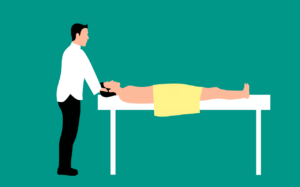
Tossing and turning in bed, desperately trying to find a comfortable position, neck and shoulder pain can become an unwelcome companion at night. As the day comes to a close, this discomfort seems to intensify, leaving you restless and drained in the morning. But fear not, there are simple and effective ways to alleviate this nighttime agony. In this article, you will discover practical tips that can assist you in finding relief from neck and shoulder pain, allowing you to enjoy a restful slumber and wake up feeling refreshed and rejuvenated.

Adjust Your Sleeping Position
Use a firm mattress
A firm mattress can provide better support for your neck and shoulders, helping to alleviate pain. When your mattress is too soft, it can cause your body to sink in and put extra pressure on those areas. Consider investing in a high-quality, firm mattress to support your body during the night.
Try a different pillow
Your pillow plays a crucial role in maintaining proper neck and shoulder alignment. If you are experiencing pain, it may be time to switch to a different pillow. Look for a pillow that offers adequate support and helps keep your spine aligned. Memory foam pillows or contoured cervical pillows are popular options for relieving neck and shoulder pain.
Consider sleeping on your back
Sleeping on your back can help distribute weight evenly and maintain a neutral spine alignment. This position can reduce stress on your neck and shoulders, promoting better sleep and reducing pain. If you’re not accustomed to sleeping on your back, try using pillows to support your neck and shoulders until you’re comfortable in this position.
Use a neck pillow
If you frequently wake up with a stiff neck or shoulder pain, a neck pillow can be a game-changer. These specially designed pillows provide targeted support to your neck, helping to improve your sleep quality and alleviate pain. Neck pillows are available in various shapes and sizes, so find one that suits your needs and preferences.
Improve Your Sleep Environment
Ensure proper room temperature
Maintaining the right room temperature can greatly impact your sleep quality. Extreme temperatures can lead to discomfort and even contribute to muscle tension. Keep your bedroom cool, preferably between 60 to 67 degrees Fahrenheit (15-19 degrees Celsius), to create an optimal sleep environment for your neck and shoulders.
Invest in a supportive pillow
A supportive pillow is essential for maintaining proper alignment and relieving neck and shoulder pain. Look for pillows that are specifically designed to support the natural curves of your neck and promote spinal alignment. Investing in a high-quality pillow can make a world of difference in your comfort and sleep quality.
Use a comfortable mattress
A comfortable mattress is crucial for ensuring a restful night’s sleep. If your current mattress is old or uncomfortable, it’s time to consider a replacement. Look for a mattress that provides adequate support and cushioning for your entire body, paying particular attention to your neck and shoulders. Testing out different mattress options before making a purchase can help you find the perfect fit.
Eliminate noise and distractions
Noise and distractions during the night can disrupt your sleep and exacerbate neck and shoulder pain. Take steps to create a peaceful sleep environment by eliminating sources of noise. Consider using earplugs or a white noise machine to block out unwanted sounds. Additionally, keep electronic devices out of the bedroom to minimize distractions and promote a more relaxing sleep environment.

Practice Relaxation Techniques
Deep breathing exercises
Deep breathing exercises can help relax your body and mind, reducing muscle tension and promoting better sleep. Practice slow and deep breaths, inhaling through your nose and exhaling through your mouth. Focus on releasing any tension in your neck and shoulders as you breathe out. Incorporating deep breathing exercises into your bedtime routine can help you unwind and prepare for a good night’s sleep.
Progressive muscle relaxation
Progressive muscle relaxation involves tensing and releasing different muscle groups to promote relaxation. Start by tensing your neck and shoulder muscles for a few seconds, then release and let them relax completely. Move on to other muscle groups, such as your arms, legs, and back, gradually working your way through your entire body. This technique can help relieve tension and prepare your body for restful sleep.
Yoga or stretching
Yoga and stretching exercises can help relieve tension in your neck and shoulder muscles. Gentle stretches that target these areas can promote relaxation and improve flexibility. Incorporate yoga or stretching into your daily routine, especially before bedtime. Focus on gentle and controlled movements, and always listen to your body’s limits to avoid any strain or injury.
Meditation or mindfulness
Practicing meditation or mindfulness can calm your mind and reduce stress, leading to better sleep quality. Find a quiet place, close your eyes, and focus on your breath or a specific object. As thoughts arise, acknowledge them without judgment and gently bring your attention back to your breath. Engaging in regular meditation or mindfulness practice before bed can help promote relaxation and alleviate neck and shoulder pain.
Apply Heat or Cold Therapy
Use a hot compress
Applying a hot compress to your neck and shoulders can help relax tense muscles and increase blood flow to the area. You can use a hot water bottle, a heated towel, or a microwavable heat pack. Apply heat for about 15-20 minutes, making sure it’s not too hot to avoid burns. Heat therapy can help alleviate pain and promote relaxation before bedtime.
Try a cold pack
If you have inflammation or swelling in your neck and shoulders, cold therapy may be more beneficial. Use a cold pack or a bag of frozen peas wrapped in a thin towel. Apply it to the affected area for approximately 15 minutes. Cold therapy can help reduce inflammation and numb the area, providing relief from pain and discomfort.
Alternate heat and cold therapy
Some individuals find relief by alternating between heat and cold therapy. Start with a hot compress for 15 minutes, followed by a cold pack for 15 minutes. Repeat this cycle a few times, always ending with cold therapy. This combination can help reduce inflammation, relax muscles, and promote better sleep.
Experiment with different temperatures
Each individual may have different preferences when it comes to heat or cold therapy. Experiment with different temperatures to find what works best for you. Some people find relief with a warm shower before bed, while others prefer an ice pack. Pay attention to how your body responds to different temperatures and adjust accordingly.

Use Over-the-Counter Pain Relief
Take nonsteroidal anti-inflammatory drugs (NSAIDs)
Over-the-counter nonsteroidal anti-inflammatory drugs (NSAIDs), such as ibuprofen or naproxen sodium, can help reduce pain and inflammation in your neck and shoulders. However, it’s essential to follow the recommended dosages and guidelines provided by the manufacturer. If pain persists or worsens, consult a healthcare professional for further evaluation and advice.
Apply topical pain relief creams or ointments
Topical pain relief creams or ointments can provide temporary relief from neck and shoulder pain. Look for products containing ingredients like menthol, camphor, or capsaicin, as these can help soothe the affected area. Follow the instructions on the product packaging and avoid applying excessive amounts to prevent skin irritation.
Consider natural pain relief options
If you prefer natural alternatives, several options may help alleviate neck and shoulder pain. Essential oils, such as lavender or peppermint oil, can be diluted and applied topically for their soothing properties. Additionally, herbal remedies like arnica or turmeric may provide temporary relief. Consult with a healthcare professional or a licensed herbalist to ensure the safety and appropriate use of natural pain relief options.
Consult a healthcare professional
If your neck and shoulder pain persist or significantly affect your sleep quality, it’s crucial to consult a healthcare professional. They can determine the underlying cause of your pain and recommend appropriate treatments or therapies. They may also provide guidance on over-the-counter pain relief options or suggest further investigations to identify the root cause of your discomfort.
Practice Good Posture During the Day
Optimize your workstation setup
Proper posture during the day is essential for maintaining a healthy neck and shoulder alignment. Adjust your workstation setup to promote good posture. Ensure that your computer monitor is at eye level, and your chair and desk are ergonomically designed. Sit with your feet flat on the floor and your back against the chair’s backrest to reduce strain on your neck and shoulders.
Take frequent breaks to stretch and move
Sitting or standing in the same position for long periods can contribute to neck and shoulder pain. Take regular breaks throughout the day to stretch and move your body. Perform simple neck and shoulder stretches, roll your shoulders, or take short walks to relieve tension and promote blood circulation.
Engage in posture-correcting exercises
Specific exercises can help strengthen the muscles that support proper posture. Focus on exercises that target your neck and shoulder muscles, such as chin tucks, shoulder rolls, or shoulder blade squeezes. Incorporate these exercises into your daily routine to improve your posture and reduce the risk of neck and shoulder pain.
Use ergonomic accessories
Consider using ergonomic accessories to support good posture throughout the day. A supportive office chair with adjustable features, an ergonomic keyboard and mouse, or a standing desk can help reduce strain on your neck and shoulders. These accessories can assist in maintaining proper alignment and decreasing the likelihood of pain during the night.
Strengthen Your Neck and Shoulder Muscles
Perform neck and shoulder exercises
Exercising and strengthening your neck and shoulder muscles can help prevent pain and improve your overall posture. Simple exercises like neck stretches, shoulder shrugs, or lateral raises can target these specific areas and improve their strength and flexibility. Incorporate these exercises into your routine a few times a week for best results.
Try resistance training
Resistance training with weights or resistance bands can help build muscle strength in your neck and shoulders. Start with lighter weights and gradually increase the resistance as you become more comfortable. Focus on exercises like chest presses, lateral raises, or rows to target these muscle groups effectively.
Incorporate yoga or Pilates
Yoga and Pilates can be beneficial for strengthening and stretching the muscles in your neck and shoulders. These practices emphasize core strength, flexibility, and body awareness. Consider joining a yoga or Pilates class, or follow instructional videos at home to incorporate these exercises into your routine.
Work with a physical therapist
If you’re experiencing chronic or severe neck and shoulder pain, it may be beneficial to work with a physical therapist. They can assess your specific muscle imbalances, provide tailored exercises, and guide you through proper techniques to alleviate pain and promote optimal muscle function. A physical therapist can also help address any underlying issues that may be contributing to your discomfort.
Avoid Activities that Aggravate Pain
Limit screen time
Excessive screen time, whether from computers, smartphones, or tablets, can strain your neck and shoulder muscles. Take breaks from screens regularly and be mindful of your posture while using these devices. Position your screens at eye level and keep them at a comfortable distance to reduce strain on your neck and shoulders.
Avoid heavy lifting
Lifting heavy objects incorrectly can put unnecessary strain on your neck and shoulder muscles. Ensure you use proper lifting techniques, keeping your back straight, bending at the knees, and engaging your leg muscles. If possible, use equipment or ask for assistance when handling heavy items to reduce the risk of injury and pain.
Modify repetitive movements
Repetitive movements, such as typing or using a mouse, can contribute to muscle fatigue and strain in your neck and shoulders. Modify these movements to prevent overuse injuries. Use ergonomic tools, take regular breaks, and incorporate stretching exercises into your routine to relieve tension and reduce the likelihood of pain.
Take proper rest breaks
Working for long hours without breaks can lead to muscle fatigue and discomfort. Schedule regular rest breaks throughout the day to give your neck and shoulder muscles time to rest and recover. Use these breaks to stretch, change positions, and relax your muscles. Taking care of your body during the day can contribute to better sleep quality at night.
Manage Stress and Anxiety
Identify stress triggers
Stress and anxiety can manifest as tension in your neck and shoulder muscles. Take time to reflect and identify the specific triggers that cause you stress. Whether it’s work-related, personal, or environmental factors, recognizing these triggers can help you develop effective strategies to manage and reduce stress.
Practice stress-reducing techniques
Implement stress-reducing techniques into your daily routine to promote relaxation and alleviate tension. Deep breathing exercises, meditation, or listening to calming music can help calm your mind and relax your body. Find activities that help you unwind and make them a regular part of your routine.
Seek support from loved ones
Talking to loved ones about your stress or anxiety can provide emotional support and a sense of relief. Share your concerns with a trusted friend or family member and let them know how you’re feeling. Sometimes, simply expressing your emotions and knowing you’re not alone can help reduce stress levels and promote well-being.
Consider professional counseling
If stress or anxiety becomes overwhelming and affects your daily life, consider seeking professional counseling. A mental health professional can provide guidance, coping strategies, and support tailored to your specific needs. They can help you develop effective stress management techniques and address any underlying issues contributing to your neck and shoulder pain.
Preventive Measures for Long-Term Relief
Maintain a healthy lifestyle
Maintaining a healthy lifestyle can contribute to long-term relief from neck and shoulder pain. Focus on eating a balanced diet, staying hydrated, and getting regular exercise. A healthy lifestyle can support overall well-being and reduce the likelihood of pain and discomfort.
Engage in regular exercise
Regular exercise, including cardiovascular activities, strength training, and flexibility exercises, can help improve muscle strength and flexibility. Aim for at least 150 minutes of moderate-intensity exercise per week, focusing on exercises that target your neck, shoulders, and posture. Consult with a healthcare professional before starting any new exercise regimen, especially if you have pre-existing conditions or injuries.
Promote good sleep hygiene
Incorporate good sleep hygiene practices into your daily routine to support better sleep. Establish a consistent sleep schedule, create a calming bedtime routine, and ensure your sleep environment is comfortable and conducive to sleep. By prioritizing sleep and practicing healthy sleep habits, you can reduce the likelihood of waking up with neck and shoulder pain.
Listen to your body’s signals
Pay attention to your body’s signals and address any discomfort promptly. If you experience persistent neck and shoulder pain, consult a healthcare professional for a proper diagnosis and treatment plan. Ignoring or neglecting your body’s warnings can result in worsening pain and potentially lead to more severe health issues.
By implementing these strategies, adjusting your sleeping position, improving your sleep environment, practicing relaxation techniques, applying heat and cold therapy, using over-the-counter pain relief, practicing good posture during the day, strengthening your neck and shoulder muscles, avoiding aggravating activities, managing stress and anxiety, and incorporating preventive measures into your lifestyle, you can find relief from neck and shoulder pain and improve your overall well-being. Remember to always consult with a healthcare professional if you have persistent or severe pain to receive appropriate guidance and treatment.







